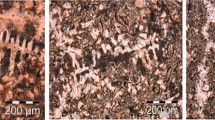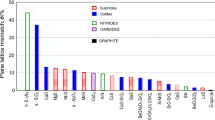Abstract
Slightly hypoeutectic ductile irons (4.10–4.2%CE) have a specific response to inoculation, which slightly decreased the temperature of the start of austenite formation (TAL), quickened up the start of eutectic freezing (nucleation) and increased the lowest and the highest (recalescence) eutectic temperatures. Temperature of the end of solidification increasing, with more negative level of the minimum value of the first derivative of cooling curve on the end of solidification, illustrates the efficiency of the applied inoculation to control the latter part of solidification. Increased graphitization factor, illustrating the graphite formation in the second part of eutectic reaction, sustains also the positive effect of inoculation. Inoculated irons show lower cooling rate for all of specific intervals than un-inoculated irons, with increasing tendency from beginning to the end of solidification, as specific values and also as difference between un- and inoculated irons. Inoculation potential, as ratio between the level of one specific parameter in inoculated and un-inoculated irons, has specific position, for each thermal analysis parameter, increasing from the beginning to the end of solidification. This treatment is useful not only to improve some metallurgical events at the beginning of solidification (carbide to graphite transition, graphite morphology control, eutectic cells count) but also it must be capitalized to control the last part of solidification, when the integrity of castings is decided.









Similar content being viewed by others
References
Upadhya KG, Stefanescu DM, Lieu K, Yeager DP. Computer-aided cooling curve analysis: principles and applications in metal casting. AFS Trans. 1989;97:61–6.
Barlow JO, Stefanescu DM. Computer-aided cooling curve analysis revisited. AFS Trans. 1997;104:349–54.
Stefanescu DM. Thermal analysis-theory and applications in metal casting. Int J Metalcasting. 2015;9(1):7–22.
Emadi D, Whiting LV, Nafisi S, Ghomashchi R. Applications of thermal analysis in quality control of solidification processes. J Therm Anal Calorim. 2005;81:235–42.
Dioszegi A, Svensson IL. On the problems of thermal analysis of solidification. Mater Sci Eng, A. 2005;413–414:474–9.
Sillen RV. Novacast technologies. 2006. www.novacast.se.
Sparkman D. Microstructure by Thermal Analysis. AFS Trans. 2011;119:413–9.
Kanno T, Nakae H. Prediction of graphite types and mechanical properties in cast iron using three cups thermal analysis. J JFS. 2000;72:175–80.
Stan S, Chisamera M, Riposan I, Barstow M. Applications of thermal analysis to monitor the quality of hypo-eutectic cast irons during solidification in sand and metal moulds. J Therm Anal Calorim. 2012;110(3):1185–92.
Riposan I, Chisamera M, Stan S. Application of cooling curve analysis in solidification pattern and structure control of grey cast irons. J Therm Anal Calorim. 2018;132:1017–28.
Ojo SS, Riposan I. Alloy selection for in the mould inoculation to control chill width in ductile iron. Mater Sci Technol. 2012;28(5):576–81.
Zhao H, Liu B. Modelling of stable and metastable eutectic transformation of spheroidal graphite iron casting. ISIJ Int. 2001;41(9):986–91.
Riposan I, Chisamera M, Stan S, White D. Role of residual aluminium in ductile iron solidification. AFS Trans. 2007;115:423–33.
Chisamera M, Riposan I, Stan S, White D. Influence of residual aluminium on solidification pattern of ductile iron. Int J Cast Met Res. 2009;22(7):401–10.
Riposan I, Chisamera M, Stan S, Toboc P, Grasmo G, White D, Ecob C, Hartung C. Benefits of residual aluminium in ductile iron. J Mater Eng Perform. 2011;20(1):57–64.
Kanno T, Iwami Y, Kang I. Prediction of graphite nodule count and shrinkage tendency in ductile cast iron with 1 cup thermal analysis. J Metalcasting. 2017;11(1):94–100.
Regordosa A, Llorca-Isern N. Microscopic characterization of different shrinkage defects in ductile irons and their relation with composition and inoculation process. Int J Metalcasting. 2017;11(4):778–89.
Li WZ, Liu BC, Li JR. Shrinkage behaviour of spheroidal graphite cast iron in green and dry sand moulds for the benchmarking of solidification simulation. J Mater Sci Technol. 2001;17(6):610–4.
Chisamera M, Riposan I, Stan S, Toboc P, Skaland T, White D. Shrinkage evaluation in ductile iron as influenced by mould media and inoculant type. Int J Cast Metal Res. 2011;24(1):28–36.
Stan S, Riposan I, Chisamera M, Barstow M. Solidification pattern of silicon alloyed ductile cast irons. In: Proceedings of the 122nd American foundry society metalcasting congress, April 2018, Fort Worth, TX, USA, Paper 18-022.
Stan S, Riposan I, Chisamera M, Stan I. Solidification characteristics of silicon alloyed ductile cast irons. J Mater Eng Perform. 2019;28(1):278–86.
Dawson S, Popelar P. Thermal analysis and process control for compacted graphite iron and ductile iron. In: Proceedings of the 2013 Keith Millis symposium on ductile iron, Nashville, TN, USA, 2013; p. 59–65.
Kanno T, Fukuda Y, Morinaka M, Nakae H. Effect of alloying elements on graphite and cementite eutectic temperature of cast iron. J. JFS. 1998;70:465–70.
Stan S, Chisamera M, Riposan I, Stefan E, Neacsu L, Cojocaru AM, Stan I. Integrated system of thermal/dimensional analysis for quality control of gray and ductile iron castings solidification. J Metalcasting. 2019;13(3):653–65.
Riposan I, Stan S, Chisamera M, Neacsu L, Cojocaru AM, Stefan E, Stan I. Control of solidification pattern of cast irons by simultaneous thermal and contraction/expansion analysis. In: IOP conference series: materials science and engineering 529 (2019) 012016 (6PAGES). https://doi.org/10.1088/1757-899x/1/012016.
Funding
Funding was provided by Unitatea Executiva pentru Finantarea Invatamantului Superior, a Cercetarii, Dezvoltarii si Inovarii (Grant No. 115PED; PN-III-P2-2.1-PED-2016-1793).
Author information
Authors and Affiliations
Corresponding author
Additional information
Publisher's Note
Springer Nature remains neutral with regard to jurisdictional claims in published maps and institutional affiliations.
Rights and permissions
About this article
Cite this article
Cojocaru, A.M., Riposan, I. & Stan, S. Solidification influence in the control of inoculation effects in ductile cast irons by thermal analysis. J Therm Anal Calorim 138, 2131–2143 (2019). https://doi.org/10.1007/s10973-019-08808-2
Received:
Accepted:
Published:
Issue Date:
DOI: https://doi.org/10.1007/s10973-019-08808-2




